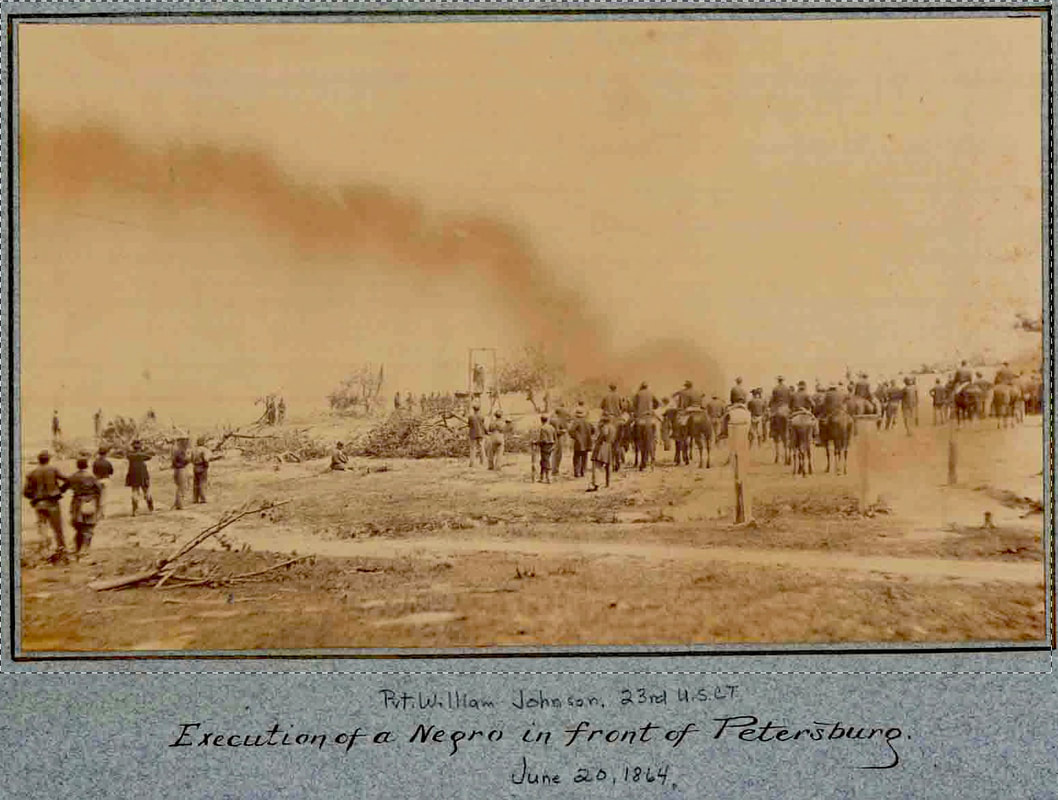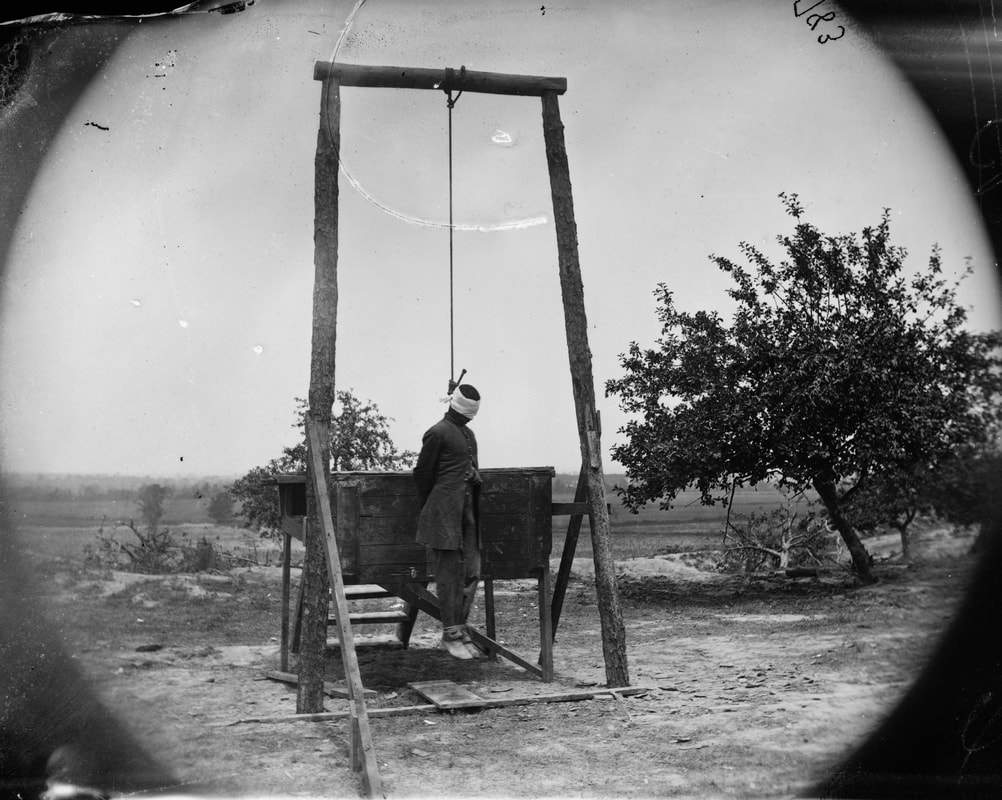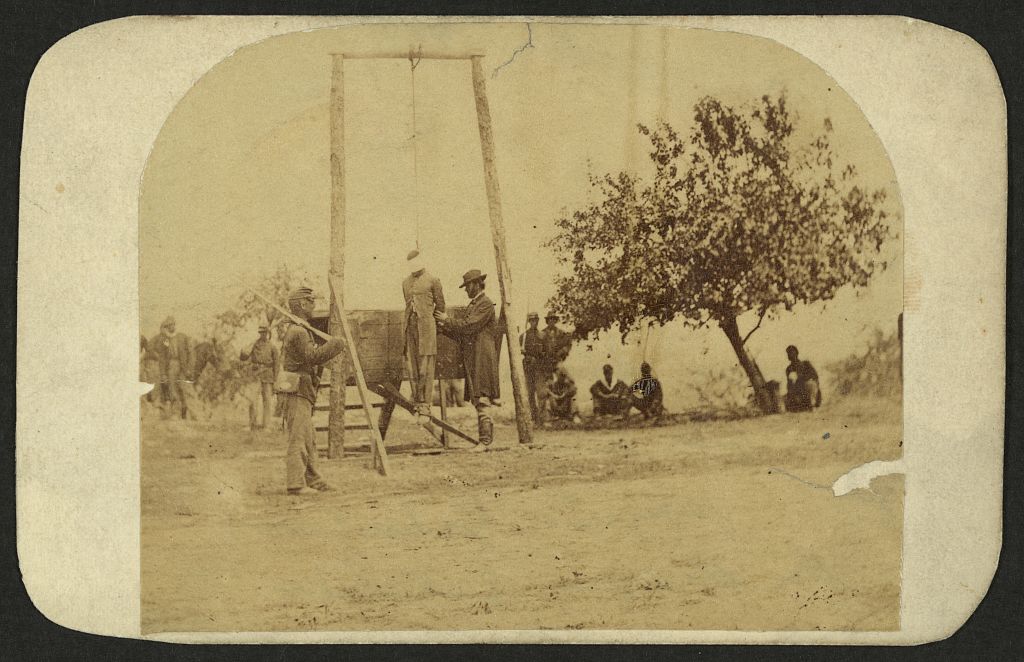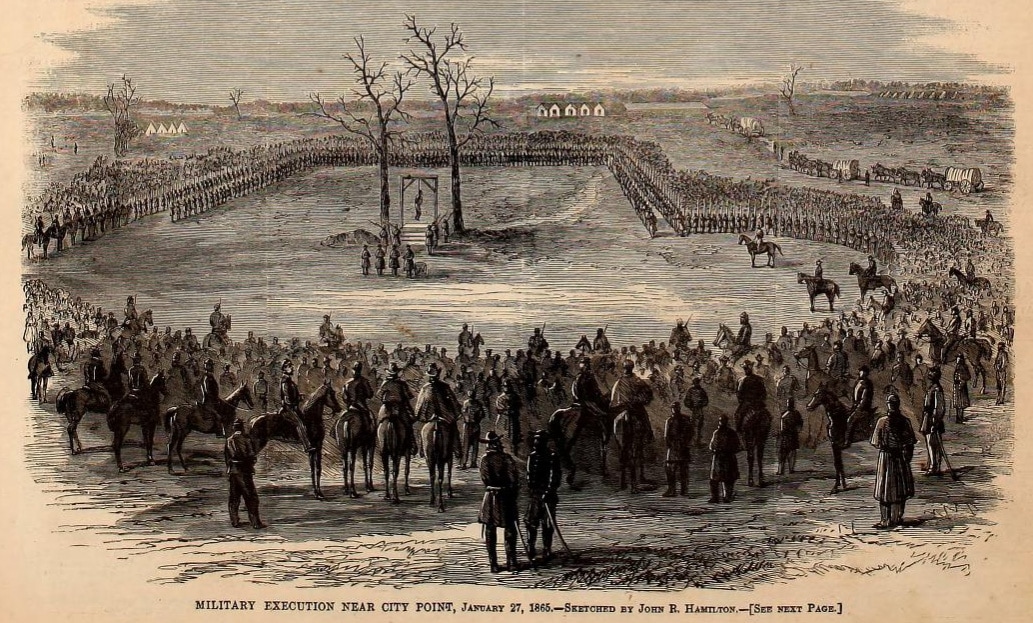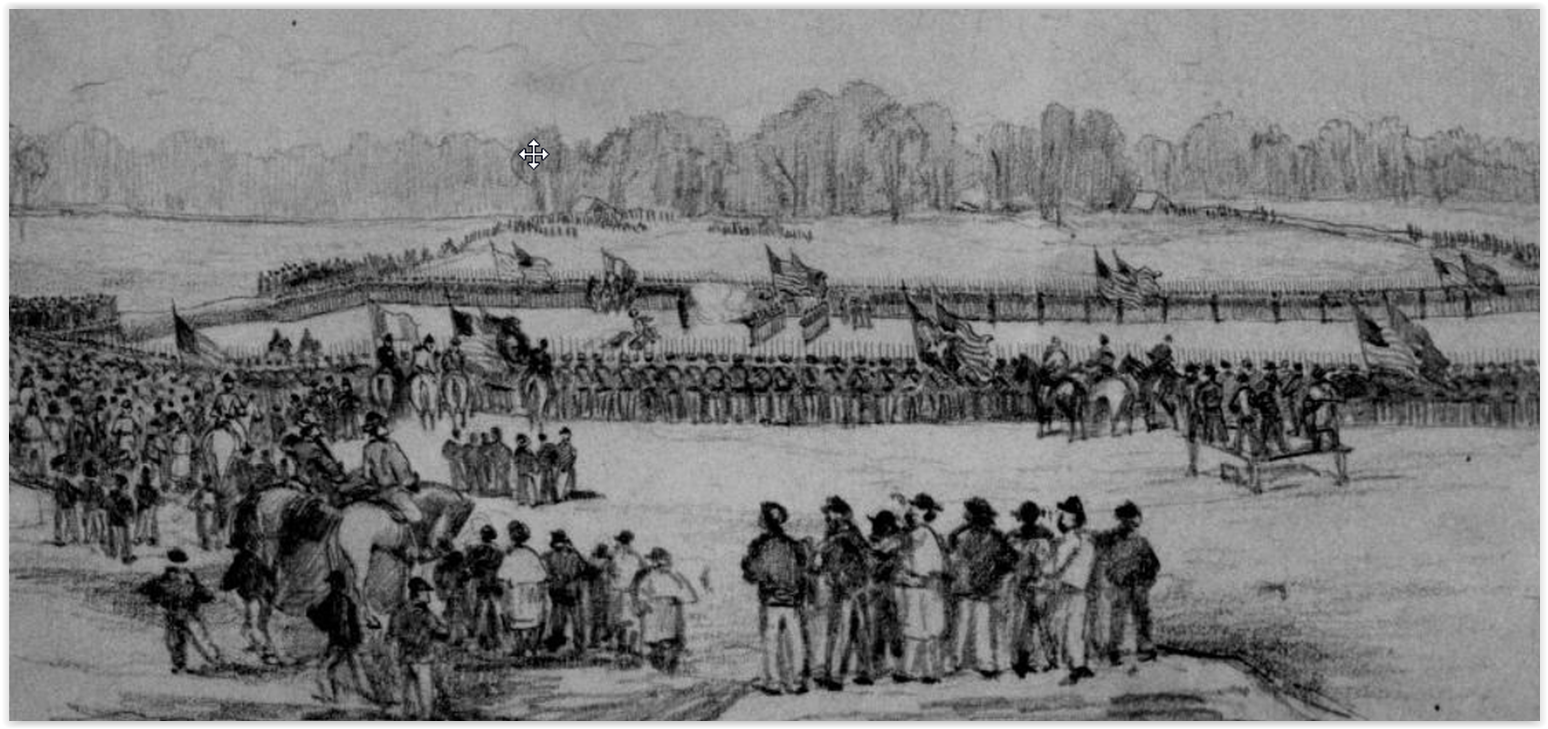Execution of Johnson at Jordan's Farm, June 20, 1864
June 19-20 [1864]. …On the 20th, a scaffold was erected by the Battalion, in plain view of the enemy, and a negro hanged on it, after due trial. Private Perkins, of Company B, pulled the fall.
--Gilbert Thompson, “The Engineer Battalion in the Civil War: A Contribution to the History of the United States Engineers”. Number 44, Occasional Papers, Engineer School, U.S. Army. Press of the Engineer School 1910:71.
--Gilbert Thompson, “The Engineer Battalion in the Civil War: A Contribution to the History of the United States Engineers”. Number 44, Occasional Papers, Engineer School, U.S. Army. Press of the Engineer School 1910:71.
This execution took place on Jordan's farm, but where? Photographic evidence gives the impression the gallows was near the edge of the hilltop where the plantation house and Confederate Battery 5 stood. A close look at a photograph taken within Battery 5 reveals the top of the gallows seen above the western parapet of the battery. William A. Frassanito dates this photograph no earlier than June 21 when a section of the 1st Connecticut Artillery under Captain John A. Burton and their heavy Parrott guns were moved into position to counter Confederate artillery on the north bank of the Appomattox. He argues the photograph was taken in late June (Grant and Lee: the Virginia Campaigns, 1864-1865, 232-233). If so, the gallows used on June 20th still stood a week or so later.
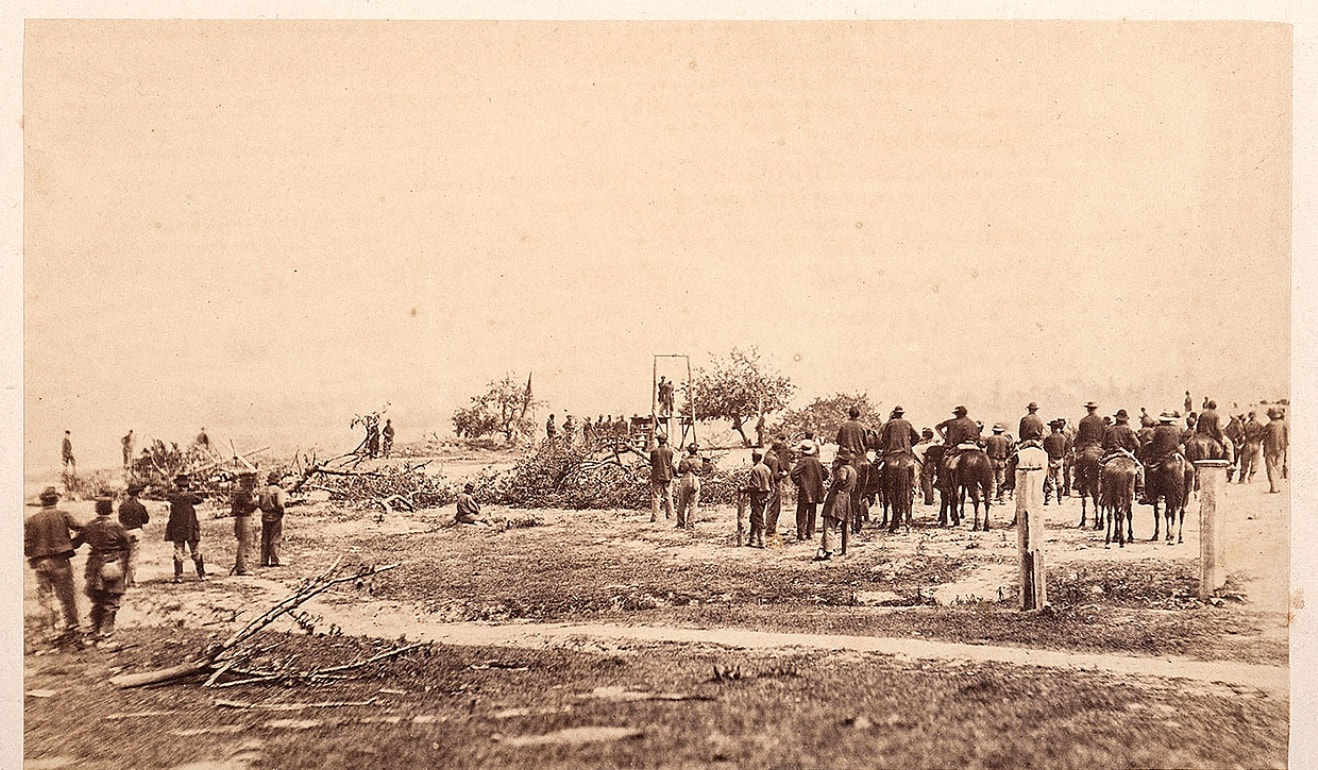
"William Johnson's execution at Jordan's Farm., June 20, 1864." Albumen print in a private collection, sold on Cowan in 2015.This is an important piece in locating the site of the scaffold. US Battery 4/ CS Battery 5 is at the right edge of the image, lost in the haze. The tree next to the gallows is visible in photos taken inside the fort.
Military Execution Near City Point, January 27, 1865
A MILITARY EXECUTION
We illustrate on page 109 the military execution of private Newell W. Root, alias George H. Harris, for the crime of desertion, at City Point, January 27, 1865. It appears that, deluded by General LEE’S Order No. 65, he had made his way through the revel lines and found his way to Louisa Kentucky, where he was arrested while attempting to pass himself off as one of their deserters. He was one of 170 misguided men who had deserted to the enemy, and left Richmond on the 10th October last. Seventy of these have already been, arrested, fifteen executed, and unrelenting martial law is still on the track of the remainder.
New York Times FROM CITY POINT.; Imposing Military Execution near City Point Full Details of the Event
CITY POINT, Va., Friday, Jan. 27, 1865.
Another military execution took place to-day, under circumstances which made it a scene of unusual grandeur and solemnity. It occurred within our inner fortifications. The splendor of the day, which, although intensely cold, was extremely bright and beautiful, tended to draw together a vast concourse of people, both military and civil, and this being the first time that any execution had been seen so near to City Point, doubtless tempted out many who might not have gone any distance to witness so painful a spectacle. Few who read about a military execution have any idea of its awful impressiveness. The martial character of all the surroundings; the stern, inexorable idea of power to inflict swift and summary retribution of justice, which is conveyed in the solemn movements of hundreds of stalwart men, striding along with measured step, with mournful music and glistening bayonets, make it altogether different from the disgusting spectacles too often seen where vulgar crowds are brought together -- as in Europe -- to witness civil executions. The very fact that the large majority of those present are accustomed to look on death, in every honorable shape, without a shudder or a pang, only gives intensity to the deep horror of seeing a comrade, full of life and health, die -- not amid the cheering voices of his companions, but the death of a dog -- amid the contemptuous gaze of myriads of eyes of his brothers in arms, however softened by the natural impulses of human sympathy. It is a horrible thing to witness; even more so to think of.
The unfortunate man who suffered on this occasion, was private NEWELL W. ROOT, alias GEORGE H. HARRIS, of the First Connecticut Heavy Artillery; a tail young man of prepossessing appearance, who met his doom with great composure. He was convicted of the crime of deserting to the enemy, at the court-martial of which Brevet Brig.-Gen. COLLIS is President, and which has been holding its sessions at City Point for many months past. It appears that, deluded by the Order No. 65, which the rebel Government issued in August last, he had made his way through the rebel lines, been relieved by the rebel authorities and found his way to Louisa, Ky., where he was arrested, while attempting to pass himself off as one of their deserters. He was one of 170 misguided men who had deserted to the enemy, and left Richmond on the 10th October last. Seventy of these have already been arrested, fifteen executed, and unrelenting martial law is still on the track of the remainder.
When I arrived, at noon, on the fatal spot -- about two miles out of City Point, and situated in the hollow between two gently undulating pieces of rising ground -- a large number of troops were already drawn up in three sides of a square; the gallows being placed between the naked trunks of the only two trees to be seen for a large distance around, and occupying the centre of the other side of the squad. Troops and civilians continued to arrive, on horseback, in vehicles, or on foot, until one o'clock, at which time the assemblage could not have been less than from three to four thousand people. As the troops came on they went to swell the masses of soldiers forming the three sides of the square, which opened so as to leave a wide avenue between them, along which the doomed man was to pass.
Shortly before one o'clock a squad of cavalry came up, ranged themselves at the end of one of the sides, and the criminal arrived in a guarded wagon. On slighting he had to march, preceded by a band of music playing the Dead March, followed by a bodyguard and accompanied by his chaplains and the executive military officers. The scene presented, as this group wended their dismal way along the avenue of human faces on each side was very painful. After passing along the avenue on the three sides of the square and reaching the gallows -- before which was the yawning grave and the fresh heap of earth so soon to be scattered over a still living man -- Capt. JOHN SAVAGE, of the Sixty-eighth Pennsylvania Volunteers, the officer intrusted with the whole management, mounted the scaffold -- accompanied only by the criminal, his two spiritual advisers, Rev. F. JARVIS, Chaplain of the Tenth Connecticut Heavy Artillery, Chaplain JONES, of the Tenth United States Colored, and a sergeant -- and there read, in a loud, clear voice that could be heard distinctly through the whole concourse of people, the order announcing the sentence and its charge. The whole of the little party then knelt down, the Rev. Mr. JARVIS offered up a most fervent prayer, and at this impressive moment the most awful and deathlike silence pervaded that large crowd, so that not a breath could be heard. The very horses, for a few instants, looked to me, as well as their riders, like immoveable statues, and continued so during the last thrilling and horrid details that accompany an execution of this kind. At precisely one o'clock the drop fell, and the wretched man was launched into eternity.
At the same time that this execution took place, another deserter, belonging to the Fifteenth New-York Engineer Volunteers, was to be shot; but a telegraph had, in the meantime, come from the President ordering a respite, some point having, doubtless, been raised worthy of further investigation.
Eyewitness to Executions at the Friend House
Jennie Friend Stephenson, a daughter of Charles Friend, whose house became Federal headquarters for various commanders throughout the siege, describes the grisly remnants of military executions carried out on the family property:
Old Betty… told us of the clumps of graves we found here and there about the place [the plantation]. On a hill over-hanging the ice pond, standing out in sharp outline against the sky, was a single tree, with a rope dangling from it…Under the tree many bodies, possibly a dozen, the coloring of the clothes still preserved, as we saw through the scant supply of earth upon these bodies, were buried…Other clumps of graves were in the meadow below the old servants' peach orchard, and another at the bottom of the garden, where the fig trees crowned the terrace. These we were told, were deserters, who had been court martialed in the company chamber of the house [Friend House], and were led out from that room blind folded, and shot on these spots.
-- Petersburg National Battlefield Archives: Stephenson Manuscript, originally at the Virginia Historical Society
Friend House
 LC 01292, detail. Federal troops drawn up to witness a hanging. Photograph by John Reekie. August 1864
LC 01292, detail. Federal troops drawn up to witness a hanging. Photograph by John Reekie. August 1864
Peeble's House, October 14, 1864
Updated 10/06/2023

